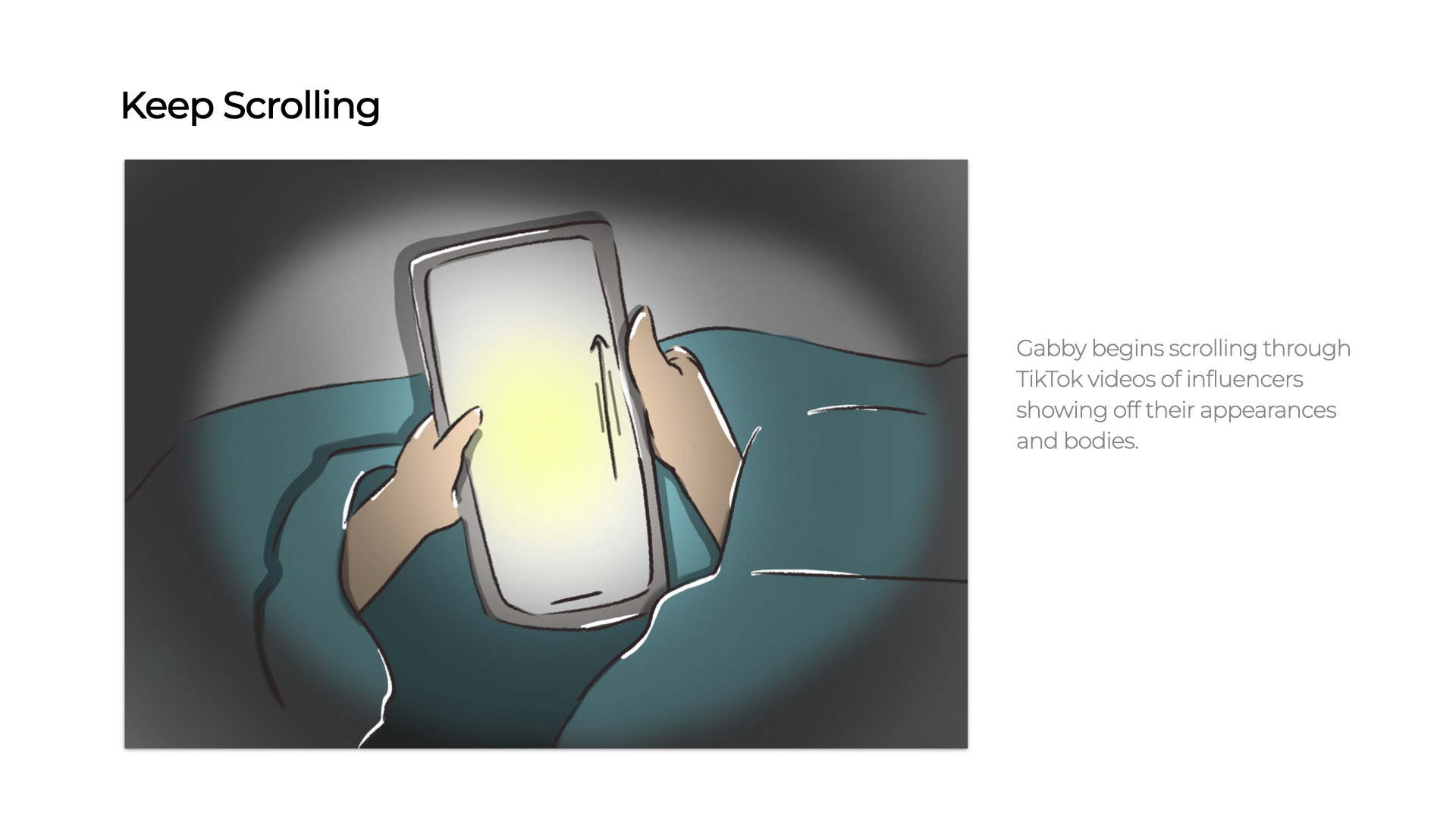About Kudos
Addressing the Effects of TikTok on Young Adult Users' Mental Health
Kudos is a social change project where my team and I have worked closely with the community and our community partners to propose changes to the interface, algorithms, and/or tools on TikTok’s platform to address the detrimental effects on young adult users' mental health.
Summary
•Project Type: UX/UI Case Study | Class Project
•Project Duration: January 2022 - May 2022
•Team Members: Me, Alyssa Brites, Michael Morra, & Steven Rodriguez
•Tools: Figma, Adobe Photoshop, Keynote, Google Forms, Google Sheets
•My Roles: Conducted user research & created journey maps, illustrated storyboard, conducted mind mapping, sketched UI & created UI comps, created high-fidelity prototype, & designed slide decks
•Location: Farmingdale State College
Our Community
TikTok College Users Ages 18-25
Community Partners & Experts: Cecilia Ambros, Doctor Marya Howell-Carter, & Professor Allison Puff
What's the Prob?
Users Often Face Social Comparisons
Users who spend time on social media can face negative experiences such as social comparisons with their life and appearance, doom scrolling, and poor mental health. Studies have found that spending more time on social media causes increased risks of developing poor mental health or a mental illness such as depression, anxiety, loneliness, self-harm, and even suicidal thoughts. With TikTok being one of the fastest-growing social media platforms ever since the pandemic, more users are facing these negative experiences.
Here's How We Can Fix It
Kudos, Providing Positivity
Kudos is a tool integrated into TikTok's platform where users' feelings are used to activate randomly planned events that are designed to break up their feeds and provide them with positive messages, challenges, and positive algorithms.
Design Process
15 Weeks
User Research
2 Research Methods Conducted
Observation Analysis
Learning Unexpected Behaviors
Each team member conducted 4 observation analyses. In each observation, we analyzed the user watching 5 videos. Through each video, we would record the type of video, the user's view duration, interaction with the video, and thoughts on the video. All the data collected was recorded in a Google Sheet.
The observations gave us insight into behaviors we did not expect. In an observation I conducted, the user felt negative about her appearance after seeing an influencer she thought was “pretty”. However, she decided to click on the influencer's profile to take a quick glance at her feed. This made me question why the user continued to see the influencer despite the negative effects.
Survey
Users Felt Negative When Comparing Appearances
A survey was sent to our community to further understand topics that cause social comparisons. We posted the link to our survey through social media including TikTok to recruit respondents. Based on the data collected, we found that most users felt negative when they compared themselves to their appearance. The second-highest category where we found users felt the most negative after making comparisons was lifestyle, fitness, and health.
Journey Map
@ryan Questions His Appearance After Using TikTok
Rather than creating personas separately, we developed personas in conjunction with the creation of journey maps. Each team member was responsible for creating their own journey map. Here is my journey map of @ryan.
Storyboard
Impact of TikTok On Gabby
Alyssa and I decided to illustrate a storyboard to picture a possible scenario of how TikTok users will feel and interact with the videos they see on their TikTok feed. To showcase social comparison in these series of illustrations, we decided to use two different types of drawing styles where the main character Gabby, is drawn with sketchy lines to symbolize Gabby as being incompetent. Meanwhile, the famous influencer shown in Gabby's TikTok feed is drawn in a manga style to show details and symbolize the influencer being well put together.












Mind Mapping
"This Is a Sandwich".
Below, we began mind mapping and grouping ideas. We focused on how we can incorporate music, meaningful messages, and video games into the solution.
Discovering Kudos
Kudos, Sending Positive Messages On TikTok
Based on the mind mapping activity, we came across the idea of Kudos where users can send each other and access positive messages.
UI Sketches
Introducing The Flying Birdy
During the UI sketching process, the team divided different parts of the app to sketch. I decided to sketch screens that involve with home screen and sending positive messages.
UI Comps & System Requirements
Ok, We'll Have A Flying Cat Instead.
After sketching, we went straight to wireframing and prototyping. I enjoyed playing with different gifs to make the prototype appear more realistic and similar to TikTok. Below shows the screens for what happens when users unlike a video, when they receive kudos, when they send a positive message, and when they complete a challenge.
Reflection
Team Project Created Team Bonding
This recent spring semester, my team and I were able to create a high-fidelity prototype of a proposed change to the interface, algorithms, and tools on TikTok’s platform to address the detrimental effects on young adult users' mental health. Due to time constrain, we were not able to complete user testing as shown in the Agile UX Process.
A roadblock for this project was the inability to find a "normal" community partner since we are covering TikTok's tools. To deal with this, we met with Cecilia Ambros, an interaction design expert, weekly to discuss the current status of our project while receiving feedback and guidance on future steps.
However, this project was an amazing learning process as my team was able to learn how to design with the community to create a social impact. At the same time, we learned more about our generation and how we can spread positive influence through social media.
